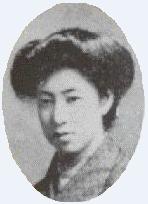Hiratsuka Raichō

Raichō Hiratsuka (平塚 らいてう, Hiratsuka Raichō, February 10, 1886 - May 24, 1971) was a writer, journalist, political activist and pioneering Japanese feminist.
Life
Born Haru Hiratsuka (平塚 明 Hiratsuka Haru) in Tokyo in 1886, the second daughter of a high ranking civil servant. Entering Japan Women's University (日本女子大学) in 1903, she came to be influenced by contemporary currents of European philosophy, as well as Zen Buddhism, of which she would become a devoted practitioner. Of particular influence to her was turn-of-the-century Swedish feminist writer Ellen Key, some of whose works she translated into Japanese. Upon graduation from university, she entered the Narumi Women's English School where, in 1911, she founded Japan's first all-women literary magazine, Seitō (青鞜社, Bluestocking), whose first issue she opened with the words “In the beginning, woman was the sun.” (「元始、女性は太陽であった」) – a reference to the Shinto myth of creation – and whose contributors included renowned poet and women’s rights proponent Yosano Akiko among others. Adopting the pen name “Raichō” (“Thunderbird”), she began to call for a women’s spiritual revolution, and within its first few years the journal’s focus shifted from literature to women’s issues, including candid discussion of female sexuality, chastity and abortion. The journal quickly gained notoriety and several issues fell foul of the state censors. Meanwhile, in 1914, Hiratsuka began living openly with her younger lover, artist Okumura Hiroshi, with whom she had two children out of wedlock and eventually married in 1941. The journal folded in 1915, but not before establishing its founder as a leading light in Japan’s nascent women's movement.
In 1920, following an investigation into female workers' conditions in textile factories in Nagoya which further galvanized her political resolve, Hiratsuka founded the New Women's Association (新婦人協会) together with fellow women's rights activist Ichikawa Fusae. It was largely through this group's efforts the Article 5 of the Police Security Regulations, which, enacted in 1900, had barred women from joining political organizations and holding or attending political meetings, was overturned in 1922. Women's suffrage, however, remained elusive in Japan. A further – and more controversial – campaign which Hiratsuka led was a campaign to ban men with venereal disease from getting married. This unsuccessful campaign remains a point of controversy surrounding Hiratsuka’s career in that it saw her aligned herself with the eugenics movement, asserting that the spread of V.D. was having a detrimental effect on the Japanese “race.”
The next couple of decades saw Hiratsuka withdraw somewhat from the public eye, saddled with debts and her lover beset with health problems, although she would continue to write and lecture. The postwar years, however, saw her emerge anew as a public figure through the peace movement. In 1950, the day after the outbreak of the Korean War, she traveled to the United States together with writer and activist Nogami Yaeko and three other members of the Japan Women's Movement (婦人運動家) in order to present US Secretary of State Dean Acheson with a request that a system be created in which Japan could remain neutral and pacifist. Hiratsuka continued to champion women's rights in the postwar era, founding the New Japan Women's Association (新日本婦人の会) in 1963 together with Nogami and noted artist Iwasaki Chihiro, and continuing to write and lecture up until her death in 1971.
Legacy
While her career as a political activist covered many decades, Hiratsuka is primarily remembered for her stewardship of the Seitō group. As a leading light of the women’s movement in early twentieth century Japan, she was a highly influential figure whose devotees ranged from pioneering Korean feminist author Na Hyesok (나혜석; 羅蕙錫) who was a student in Tokyo during Seitō’s heyday to anarchist and social critic Ito Noe whose membership in the Seitō organization generated some controversy. Her postwar organization, the New Japan Women’s Organization, remains active to this day.
Selected works
Original works
- 『円窓より』 (Marumado yori, The View from the Round Window)
- 『元始、女性は太陽であった』 (Genshi, josei wa taiyo de atta, In The Beginning Woman Was The Sun)
- 『私の歩いた道』 (Watakushi no aruita michi, The Road I Walked)
Translations
- Ellen Karolina Key, The Renaissance of Motherhood (『母性の復興』, Bosei no fukko)
- Ellen Karolina Key, Love and Marriage (『愛と結婚』, Ai to kekkon)
Sources
- 父が子に送る一億人の昭和史:人物現代史 (One Hundred Million People's Showa History from Father to Child – Modern Biographical Histories), Mainichi Shimbun Press, 1977.
- Sumiko Otsubo, Engendering Eugenics: Women's Pursuit of Anti-V.D. Marriage Restriction Law in Taisho Japan, Ohio State University Press.
See also
- BlueStockings Journal (Seitō-sha)
- Feminism
- Fusae Ichikawa
- Ellen Key
- Akiko Yosano
